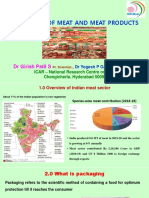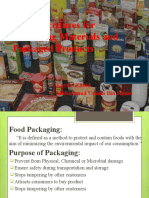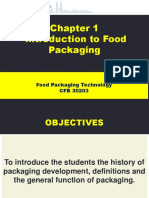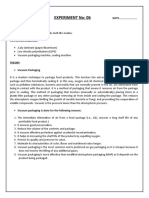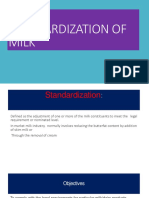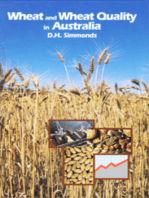0 ratings0% found this document useful (0 votes)
57 viewsAsepticpackaging
Asepticpackaging
Uploaded by
Swarupa LimayeAseptic packaging allows foods to be processed and packaged in a way that increases shelf life without refrigeration. It involves sterilizing foods, packaging materials, and equipment to prevent recontamination. The food is high temperature processed and immediately sealed in sterile packaging. Common packaging materials include cartons, bags, and bottles. Aseptic packaging allows foods to be stored at room temperature for months without refrigeration, providing convenience for consumers while preserving quality and nutrients.
Copyright:
© All Rights Reserved
Available Formats
Download as PPT, PDF, TXT or read online from Scribd
Asepticpackaging
Asepticpackaging
Uploaded by
Swarupa Limaye0 ratings0% found this document useful (0 votes)
57 views23 pagesAseptic packaging allows foods to be processed and packaged in a way that increases shelf life without refrigeration. It involves sterilizing foods, packaging materials, and equipment to prevent recontamination. The food is high temperature processed and immediately sealed in sterile packaging. Common packaging materials include cartons, bags, and bottles. Aseptic packaging allows foods to be stored at room temperature for months without refrigeration, providing convenience for consumers while preserving quality and nutrients.
Original Description:
ppt on aseptic packaging of food
Original Title
asepticpackaging-
Copyright
© © All Rights Reserved
Available Formats
PPT, PDF, TXT or read online from Scribd
Share this document
Did you find this document useful?
Is this content inappropriate?
Aseptic packaging allows foods to be processed and packaged in a way that increases shelf life without refrigeration. It involves sterilizing foods, packaging materials, and equipment to prevent recontamination. The food is high temperature processed and immediately sealed in sterile packaging. Common packaging materials include cartons, bags, and bottles. Aseptic packaging allows foods to be stored at room temperature for months without refrigeration, providing convenience for consumers while preserving quality and nutrients.
Copyright:
© All Rights Reserved
Available Formats
Download as PPT, PDF, TXT or read online from Scribd
Download as ppt, pdf, or txt
0 ratings0% found this document useful (0 votes)
57 views23 pagesAsepticpackaging
Asepticpackaging
Uploaded by
Swarupa LimayeAseptic packaging allows foods to be processed and packaged in a way that increases shelf life without refrigeration. It involves sterilizing foods, packaging materials, and equipment to prevent recontamination. The food is high temperature processed and immediately sealed in sterile packaging. Common packaging materials include cartons, bags, and bottles. Aseptic packaging allows foods to be stored at room temperature for months without refrigeration, providing convenience for consumers while preserving quality and nutrients.
Copyright:
© All Rights Reserved
Available Formats
Download as PPT, PDF, TXT or read online from Scribd
Download as ppt, pdf, or txt
You are on page 1of 23
Aseptic Packaging
Why Foods are processed?
• Increase Shelf life of product
• Availability of commodity throughout year
• Wide range of products can be produce
• Convenience for consumer
How Foods products are
processed ?
• By Application of heat – Aseptic packaging
• By Removal of heat
• By Irradiation
• By Addition of sugar / salt / Additive
• Minimal Processing
• By Altering surrounding of product
Aseptic Packaging-
• It is defined as the filling of a commercially sterile
product into a sterile container under aseptic
conditions and hermetically sealing the containers so
that reinfection is prevented.
• This results in a product which is shelf stable at
ambient conditions.
• The term aseptic is derived from the Greek word
“septicos” which means the absence of putrefactive
micro organisms.
• There are two specific fields of application of aseptic
packaging technology-
1. Packaging of pre-sterilised and sterile products.
E.g. Milk and dairy products, puddings, desserts,
fruit and vegetables.
2. Packaging of non-sterile products to avoid infection
by micro-organism
E.g. Fermented dairy products like yoghurt.
• Aseptic packaging technology is fundamentally
different from that of conventional food processing
by canning.
• In canning, the process begins with treating the food
prior to filling.
• Initial operations inactivate enzymes so that these
will not degrade the product during processing.
• The package is cleaned, and the product is
introduced into the package, usually hot.
• Generally, air that can cause oxidative damage is
removed from the interior.
• The package is hermetically sealed and then
subjected to heating.
• The package must be able to withstand heat up to
about 100°C for high acid products and up to 127°C
for low acid products.
• Figure 1 is a simple illustration comparing the basic
difference between conventional canning and aseptic
packaging processes for the production of shelf-
stable food products.
Aseptic Processing – Methodology
Aseptic processing comprises the following:
• Sterilisation of the products before filling.
• Sterilisation of packaging materials or containers and
closures before filling
• Sterilisation of aseptic installations before operation (UHT
unit, lines for products, sterile air and gases, filler and relevant
machine zones)
• Maintaining sterility in this total system during operation
Sterilization of Products
• In aseptic processing, the design to achieve
commercial stability is based on the well-founded
principles of thermal bacteriology and integrated
effect of time/temperature treatment on spores of
micro-organisms.
• Pre-sterilization of a product usually consists of
heating the product to the desired UHT temperature,
maintaining this temperature for a given period in
order to achieve the desired degree of sterility.
Some of the latest methods of
sterilisation of products include:
1. Microwaves
2. Electrical resistance heating
3. High voltage discharge
4. Ultra high pressure
5. Sterilization of air by incineration
Sterilisation of Aseptic Packaging
Materials and Equipment
• Primary packaging Material
Tetrapack – LD(low denisty) / Al foil / Paperboard
Aseptic Bulk pack – EVOH (ethylene vinyl alcohol)/ Al foil / LD
Glass bottle
FFS cartons(form fill seal)
• Secondary packaging Material
Tetrapack – pack in corrugated tray with shrink wrapping
Aseptic Bulk pack – CFB(congurrated fiberboard) boxes (25 kg)
– Bag in box
Aseptic Bulk pack – Plastic Drums (50 kg)
Aseptic Bulk pack – MS Drum (mild steel) (225 kg)
Heat
• Systems employing moist heat are frequently
sterilized at temperatures ranging from 121°C to
129°C, while 176°C to 232°C is used for sterilization
by dry heat.
• Sterilization of air by incineration: Temperature
ranging from 260°C to 315°C.
Chemicals
• Hydrogen peroxide (at concentrations of 30 to 35%)
is the overwhelming choice for use as a chemical
sterilant.
• Some other chemicals are various acids, ethanol,
ethylene oxide and peracetic acid.
Radiation
• Gamma-radiation has been used for decades to
decontaminate packaging materials for use in aseptic
systems for packing acid and acidified food.
• A dose of approximately 1.5 Megaradians (Mrad) is
commonly used to decontaminate containers for acid
and acidified food.
• Ultraviolet (UV-C) light has been used to
decontaminate food contact surfaces.
Types of Aseptic Packs
• Carton Boxes, Bags and Pouches, Cups and Trays,
Bottles and Jars, Metal Cans, Plastic Cans, Composite
Cans are used for packaging.
Integrity Check for Aseptic
Packaging material
• Teardown test – Sealing strength
• Electrolytic Test – Pinhole testing
• Dye test – For pinholes in laminated cartons
• Sterility check
Composition of Tetra Pak Aseptic
Cartons
• Tetra Pak aseptic cartons are made of three basic
materials that together result in a very efficient, safe
and light-weight package.
• Each material provides a specific function Figure.
• Benefits:
Higher degree of safety, hygiene and nutrient
retention in food; Preserving taste and freshness;
Can be kept for months with no need for
refrigeration; Efficient.
Type of Package Forms available in
India
• In India, Tetra Pak offers the following
packaging systems currently:
TBA: Tetra Brik Aseptic
TCA: Tetra Classic Aseptic
TFA: Tetra Fino Aseptic
TWA: Tetra Wedge Aseptic
Advantages of Aseptic Packaging:
Convenience
Aseptic packages are portable, lightweight, and shatterproof
and easily transportable
Food Safety
The aseptic process and carton together ensure that the liquid
food or beverage inside is free from harmful bacteria and
contaminants.
No refrigeration required
Long shelf life
More nutrition
Compared with canning, products can retain more nutrients
as well as natural taste, colour and texture
Low Packaging to product ratio
Limitations
• Plant Installation cost is high as compare to canning
• Gas transmission rate of Aseptic bag/ package
• Overcooked flavour in some products
• Lack of equipment for particulate sterilization, due
especially to settling of solids and thus over
processing
Thank you…
You might also like
- EarthSci Worksheet1 M3 BelarminoDocument3 pagesEarthSci Worksheet1 M3 BelarminoAyesha Faye BelarminoNo ratings yet
- Guide To Inspections of Low Acid Canned Food Manufacturers - Part 2Document82 pagesGuide To Inspections of Low Acid Canned Food Manufacturers - Part 2william eduardo mercado navarroNo ratings yet
- Vegan+Egg+Replacement+BAKERpaper FinalDocument7 pagesVegan+Egg+Replacement+BAKERpaper FinalSQF Practitioner100% (1)
- Meat PackagingDocument22 pagesMeat PackagingkuldeepakpandeyNo ratings yet
- Troubleshooting Milk Flavor Problems - Dairy Cattle Nutrition - Penn State ExtensionDocument7 pagesTroubleshooting Milk Flavor Problems - Dairy Cattle Nutrition - Penn State ExtensionCostaEdvaldoNo ratings yet
- Aseptic Packaging Equipments, Aseptic Tank, Micro - Processor Controlled System Employed For Aseptic PackagingDocument16 pagesAseptic Packaging Equipments, Aseptic Tank, Micro - Processor Controlled System Employed For Aseptic PackagingjeffyNo ratings yet
- Aseptic PackagingDocument54 pagesAseptic Packagingsunil2700No ratings yet
- Dairy Packaging Final 1 1Document33 pagesDairy Packaging Final 1 1Avishka Divyanjali100% (1)
- Advances in Dairy ProductsFrom EverandAdvances in Dairy ProductsFrancesco ContoNo ratings yet
- Retort TechnologyDocument9 pagesRetort Technologysathwik sirigineediNo ratings yet
- Retort PouchDocument4 pagesRetort PouchAlan YeohNo ratings yet
- Packaging of Fresh and Processed MeatDocument20 pagesPackaging of Fresh and Processed MeatShriraj ThatteNo ratings yet
- Packaging of Meat and Meat Products - Dr. YogeshDocument46 pagesPackaging of Meat and Meat Products - Dr. Yogeshrajesh bethaNo ratings yet
- Meat PreservationDocument28 pagesMeat PreservationSameh GhareebNo ratings yet
- Micro-Ovenable Packages and Retortable Packages: Microwave PackagingDocument18 pagesMicro-Ovenable Packages and Retortable Packages: Microwave PackagingbhaleshNo ratings yet
- Nisin in Processed CheeseDocument10 pagesNisin in Processed CheeseSulaeman HidayatNo ratings yet
- Study On Preservation of Meat and Meat Products by Smoking.Document33 pagesStudy On Preservation of Meat and Meat Products by Smoking.Bt JewelNo ratings yet
- Fat Determination AoacDocument2 pagesFat Determination AoacMervin RecolitoNo ratings yet
- Microbiology of Concentrated MilkDocument30 pagesMicrobiology of Concentrated MilkNitric AcidNo ratings yet
- New Trends in Food Packaging and TechnologyDocument17 pagesNew Trends in Food Packaging and TechnologyAbhyudaya GuptaNo ratings yet
- Packaging Testing MethodsDocument27 pagesPackaging Testing MethodsAmna SarfrazNo ratings yet
- Food SpoilageDocument13 pagesFood SpoilageKrithishNo ratings yet
- The Importance of Food PH in Commercial Canning Operations: William McglynnDocument8 pagesThe Importance of Food PH in Commercial Canning Operations: William McglynnSena Kartika PNo ratings yet
- Bio PackagingDocument12 pagesBio PackagingSteven AmadeusNo ratings yet
- Application of Emulifiers & Stabilizers in Bakery ProductsDocument13 pagesApplication of Emulifiers & Stabilizers in Bakery ProductsPankaj Kumar JhaNo ratings yet
- Sterilization and Ultra-High-Temperature ProcessingDocument15 pagesSterilization and Ultra-High-Temperature ProcessingNishkarsh AgarwalNo ratings yet
- Total Solid in MilkDocument3 pagesTotal Solid in Milkediasianagri100% (1)
- Determination of Total Fat and Free Fat ContentDocument13 pagesDetermination of Total Fat and Free Fat ContentCesar Augusto Torres LinaresNo ratings yet
- Formulation of Value Added Low-Calorie, High Fibre Biscuits Using Flax Seeds and Stevia RebaudianaDocument8 pagesFormulation of Value Added Low-Calorie, High Fibre Biscuits Using Flax Seeds and Stevia Rebaudianascience worldNo ratings yet
- The Frying Process: Università Degli Studi Di ParmaDocument13 pagesThe Frying Process: Università Degli Studi Di ParmarinthusNo ratings yet
- Interaction Between Food Flavour & Packaging Material: Monika Mathur 2014FST29DDocument45 pagesInteraction Between Food Flavour & Packaging Material: Monika Mathur 2014FST29DMonika Mathur100% (3)
- Polymer Chemistry For Packaging ApplicationsDocument25 pagesPolymer Chemistry For Packaging ApplicationsdivyaNo ratings yet
- Food HydrocolloidsDocument9 pagesFood HydrocolloidsMatheus CelestinoNo ratings yet
- Food Safety and SanitationDocument33 pagesFood Safety and SanitationWAni WaniNo ratings yet
- Packaging of Fats and OilDocument32 pagesPackaging of Fats and OilKajal VermaNo ratings yet
- Defects in Butter..gyarsilal Yadav PDFDocument28 pagesDefects in Butter..gyarsilal Yadav PDFprahalad yadav100% (2)
- CHBH13 - Laboratory Manual 4Document8 pagesCHBH13 - Laboratory Manual 4Ysa DienteNo ratings yet
- Ammonium Bicarbonate ApplicationsDocument2 pagesAmmonium Bicarbonate ApplicationspikksiNo ratings yet
- Processed Meats and Meat Analogues: OOD NgredientsDocument4 pagesProcessed Meats and Meat Analogues: OOD NgredientsGigiPetreaNo ratings yet
- Food IrradiationDocument18 pagesFood Irradiationkashaf aslamNo ratings yet
- HUMECTANTDocument12 pagesHUMECTANTSakhtar_ft100% (2)
- 8 Bakey TechnologyDocument103 pages8 Bakey TechnologyPawan CoomarNo ratings yet
- Different Methods of Preservation of Hides and SkinsDocument2 pagesDifferent Methods of Preservation of Hides and SkinsSamartha Suwal100% (1)
- Chapter 1 Introduction To Food Packaging PDFDocument43 pagesChapter 1 Introduction To Food Packaging PDFBernardino VirgilioNo ratings yet
- BAM - S.aureusDocument4 pagesBAM - S.aureuslailinayahNo ratings yet
- Experiment N1Document2 pagesExperiment N1Poras BumniNo ratings yet
- Prof Dedi - PMR Untuk Aseptic ProcessingDocument50 pagesProf Dedi - PMR Untuk Aseptic ProcessingBlasius Aditya Putra PermanaNo ratings yet
- Procesos TérmcosDocument81 pagesProcesos TérmcosRodd PintoNo ratings yet
- Green Mango PickleDocument4 pagesGreen Mango PickleGods PowarNo ratings yet
- Gellan GumDocument39 pagesGellan GumAboo Khan100% (1)
- Dairy Lab Mannual CompleteDocument40 pagesDairy Lab Mannual CompleteZarakhankhan KhanNo ratings yet
- 2 Standardization of MilkDocument13 pages2 Standardization of MilkTarek ShaheenNo ratings yet
- 08 Disinfectants and AntisepticsDocument27 pages08 Disinfectants and Antisepticsanwini kumNo ratings yet
- Defect in Evaporated and Condensed MilkDocument4 pagesDefect in Evaporated and Condensed MilkSai NalkarNo ratings yet
- Safal Report FinalDocument25 pagesSafal Report FinalNatasha PandeyNo ratings yet
- IntroductionDocument4 pagesIntroductionCeyah Nurr0% (1)
- BrineDocument15 pagesBrinekasun12374590% (1)
- Confectionery and Chocolate ProductsDocument23 pagesConfectionery and Chocolate ProductsPamilaNo ratings yet
- Khoa Based SweetsDocument17 pagesKhoa Based SweetsRonak RawatNo ratings yet
- Production of Instant Soymilk Powders by Ultra Ltration, SprayDocument12 pagesProduction of Instant Soymilk Powders by Ultra Ltration, SprayNguyễn Quang100% (2)
- Elastic Analysis of Bolted JointsDocument6 pagesElastic Analysis of Bolted JointsAdugna GosaNo ratings yet
- Article Tablet Press Operation Sticking 10 2003 PDFDocument5 pagesArticle Tablet Press Operation Sticking 10 2003 PDFhieuNo ratings yet
- Moles 3Document4 pagesMoles 3Rafid Al NahiyanNo ratings yet
- 4 Orkot Marine ManualDocument28 pages4 Orkot Marine ManualTimmyJuriNo ratings yet
- SUSPENSIONDocument11 pagesSUSPENSIONAnoosha FarooquiNo ratings yet
- Fatigue Loading ExamplesDocument6 pagesFatigue Loading ExampleskillyriaNo ratings yet
- Architects: Structural EngineersDocument8 pagesArchitects: Structural EngineersvkNo ratings yet
- 0653 w15 Ms 33Document6 pages0653 w15 Ms 33yuke kristinaNo ratings yet
- Sub-Standard Rebars in The Indian Market An Insight PDFDocument4 pagesSub-Standard Rebars in The Indian Market An Insight PDFbrahmabulNo ratings yet
- Grade 9 Organic CompoundsDocument2 pagesGrade 9 Organic Compoundsking devesfruto82% (11)
- Interm & Top Coat (Polyurethane)Document2 pagesInterm & Top Coat (Polyurethane)Fadi HamandiNo ratings yet
- Cleaning Validation: Low TOC Alpha SwabsDocument2 pagesCleaning Validation: Low TOC Alpha SwabsCiroNo ratings yet
- 1st Year - Engg. Chemistry Lab ManualDocument33 pages1st Year - Engg. Chemistry Lab Manualgrnoida.mohitsharma2007No ratings yet
- FlammablesDocument12 pagesFlammablesSafety ManagerNo ratings yet
- Models - Cfd.elastohydrodynamic Interaction ComsolDocument18 pagesModels - Cfd.elastohydrodynamic Interaction ComsolBen FahNo ratings yet
- ETABS ColumndesignDocument1 pageETABS ColumndesignPujan NeupaneNo ratings yet
- (11!4!4) NPTEL - Gas Liquefaction and Refrigeration SystemsDocument52 pages(11!4!4) NPTEL - Gas Liquefaction and Refrigeration SystemsAhmed GuerrahNo ratings yet
- Incompatible Mode AbaqusDocument7 pagesIncompatible Mode AbaqusXuandung VuNo ratings yet
- Q MaterialDocument26 pagesQ MaterialRista SimamNo ratings yet
- US3613992A - Weather Modification MethodDocument4 pagesUS3613992A - Weather Modification MethodHerb GreenNo ratings yet
- G211 26694Document15 pagesG211 26694IvanNo ratings yet
- CHME 314 Lecture 08 Rate Laws and Stoichiometry 3Document21 pagesCHME 314 Lecture 08 Rate Laws and Stoichiometry 3AmroKashtNo ratings yet
- Jadual Pembahagian Penilaian Berterusan ScribdDocument7 pagesJadual Pembahagian Penilaian Berterusan ScribdZAKEY ABDULNo ratings yet
- Pde ReportDocument10 pagesPde ReportChellam Siva Chellam SivaNo ratings yet
- DIN 2391-2 Cijevi SpecijalneDocument10 pagesDIN 2391-2 Cijevi SpecijalneMiran VidovićNo ratings yet
- Piping & Equipt Insulation - RevDocument7 pagesPiping & Equipt Insulation - RevLuis Gabriel BautistaNo ratings yet
- MIG and TIG WeldingDocument2 pagesMIG and TIG WeldingshahzafNo ratings yet
- MT Lyell Copper Mine Prefeasibility Study Demonstrates Strong Economics Over Multi-Decade LifeDocument47 pagesMT Lyell Copper Mine Prefeasibility Study Demonstrates Strong Economics Over Multi-Decade LifeLeo PalNo ratings yet
- Who Wants To Be A Millionaire?Document61 pagesWho Wants To Be A Millionaire?MarcusB83No ratings yet












